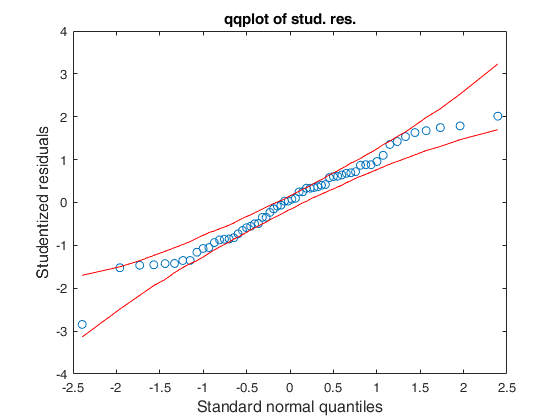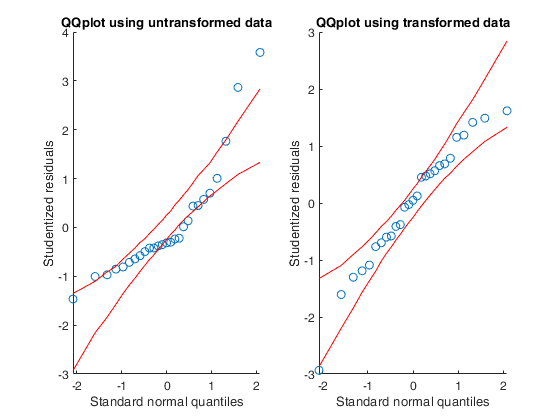Vector with n elements containing the studentized residuals from
a regression model
Data Types: single| double
Specify optional comma-separated pairs of Name,Value arguments.
Name is the argument name and Value
is the corresponding value. Name must appear
inside single quotes (' ').
You can specify several name and value pair arguments in any order as
Name1,Value1,...,NameN,ValueN.
Example:
'conflev',0.99
, 'intercept',false
, 'nsimul',300
, 'X',randn(n,3)
, 'plots',1
,'h',h1 where h1=subplot(2,1,1)
,
95, 0.975 0.99 (individual alpha)
or 1-0.05/n, 1-0.025/n, 1-0.01/n (simultaneous alpha).
Default value is 0.90
Example: 'conflev',0.99
Data Types: double
Indicator for the constant term (intercept) in the fit,
specified as the comma-separated pair consisting of
'Intercept' and either true to include or false to remove
the constant term from the model.
Example: 'intercept',false
Data Types: boolean
The
default value is 1000.
Example: 'nsimul',300
Data Types: double
Data matrix of explanatory
variables (also called 'regressors')
of dimension (n x p-1). Rows of X represent observations, and
columns represent variables. This is the matrix which has
been used to produce stdentized residuals.
If this optional argument is
missing we take as matrix X the column of ones.
Example: 'X',randn(n,3)
Data Types: double
If plots = 1, a plot which shows the
robust the qqplot of residuals with envelopes is shown on the
screen. The confidence level which is used to draw the
horizontal lines associated with the bands for the
residuals is specified in input option conflev. If
conflev is missing a nominal 0.90 confidence interval will
be used.
Example: 'plots',1
Data Types: double
Example: 'h',h1 where h1=subplot(2,1,1)
Data Types: Axes object (supplied as a scalar)
The default is to use tag 'pl_qq'. Notice
that if the program finds a plot which has a tag equal
to the one specified by the user, then the output of
the new plot overwrites the existing one in the same
window else a new window is created
Example:
'tag','mytag'
Data Types: char
 qqplot for the multiple regression data.
qqplot for the multiple regression data.
